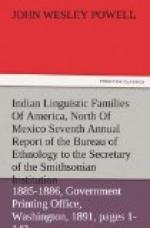The above family name was based upon a vocabulary of the Wakash Indians, who, according to Gallatin, “inhabit the island on which Nootka Sound is situated.” The short vocabulary given was collected by Jewitt. Gallatin states[103] that this language is the one “in that quarter, which, by various vocabularies, is best known to us.” In 1848[104] Gallatin repeats his Wakash family, and again gives the vocabulary of Jewitt. There would thus seem to be no doubt of his intention to give it formal rank as a family.
[Footnote 103: Archaeologia Americana, II, p. 15.]
[Footnote 104: Trans. Am. Eth. Soc. II, p. 77.]
The term “Wakash” for this group of languages has since been generally ignored, and in its place Nootka or Nootka-Columbian has been adopted. “Nootka-Columbian” was employed by Scouler in 1841 for a group of languages, extending from the mouth of Salmon River to the south of the Columbia River, now known to belong to several distinct families. “Nootka family” was also employed by Hale[105] in 1846, who proposed the name for the tribes of Vancouver Island and those along the south side of the Straits of Fuca.
[Footnote 105: U.S. Expl. Expd., vol. 6, p. 220.]
The term “Nootka-Columbian” is strongly condemned by Sproat.[106] For the group of related tribes on the west side of Vancouver Island this author suggests Aht, “house, tribe, people,” as a much more appropriate family appellation.
[Footnote 106: Savage Life, 312.]
Though by no means as appropriate a designation as could be found, it seems clear that for the so-called Wakash, Newittee, and other allied languages usually assembled under the Nootka family, the term Wakash of 1836 has priority and must be retained.
GEOGRAPHIC DISTRIBUTION.
The tribes of the Aht division of this family are confined chiefly to the west coast of Vancouver Island. They range to the north as far as Cape Cook, the northern side of that cape being occupied by Haeltzuk tribes, as was ascertained by Dr. Boas in 1886. On the south they reached to a little above Sooke Inlet, that inlet being in possession of the Soke, a Salishan tribe.
The neighborhood of Cape Flattery, Washington, is occupied by the Makah, one of the Wakashan tribes, who probably wrested this outpost of the family from the Salish (Clallam) who next adjoin them on Puget Sound.
The boundaries of the Haeltzuk division of this family are laid down nearly as they appear on Tolmie and Dawson’s linguistic map of 1884. The west side of King Island and Cascade Inlet are said by Dr. Boas to be inhabited by Haeltzuk tribes, and are colored accordingly.
PRINCIPAL AHT TRIBES.
Ahowsaht. Mowachat.
Ayhuttisaht. Muclaht.
Chicklesaht. Nitinaht.
Clahoquaht. Nuchalaht.
Hishquayquaht. Ohiaht.
Howchuklisaht. Opechisaht.
Kitsmaht. Pachenaht.
Kyoquaht. Seshaht.
Macaw. Toquaht.
Manosaht. Yuclulaht.




